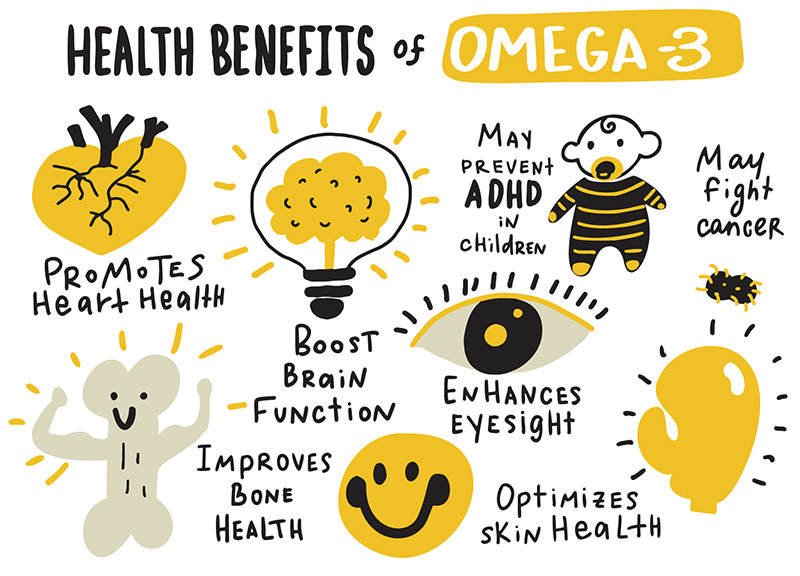- Home
- About Us
- Advanced Testing
- Nutrition & Self-Care
- Further Learning
- New Member Info
- Contact
There are good and bad fats in our diet. Omega-3 fatty acids are the good guys – these polyunsaturated fats are deemed “essential” fatty acids because they are necessary for health. But since our body cannot make these fats, they have to come from our diet. Omega-3 fatty acids help maintain the balanced production of hormone-like substances called prostaglandins. Prostaglandins help regulate many important physiological functions including inflammation, heart and vascular health, and brain and nervous system function.
Omega-3 fatty acids also play an important role in other bodily processes such as immune heath. They can help diminish allergic responses, nurture eye and skin health, improve symptoms of depression and arthritic pain, improve blood pressure and blood clotting, and even increase learning and mental development in children.

EPA and DHA are the most common type of omega-3 fatty acids and are found mostly in animal products like fish. ALA is a third type of omega 3 that is primarily found in nuts and seeds. ANY type of omega-3 can help fight inflammation in the body, but in general, EPA is promoted more for heart health and DHA is promoted more for brain health.
The standard American diet (SAD) is high in saturated and trans fats and low in healthy omega-3 fats, which creates an imbalance that affects cell membrane permeability. This imbalance impairs our ability to absorb the vitamins we need and can promote the development of disease.
Omega-6-rich oils found in sunflower, corn, and cottonseed oils can compete with healthy fats like EPA, so the oils we ingest matter; some fats have anti-inflammatory properties while others can be pro-inflammatory.
There are a few different blood tests on the market that can measure levels of omega-3 fatty acids in the blood. The Boston Heart fatty acid balance test measures levels of different good and bad fats in the blood from the previous week. This test can help ascertain whether there is an imbalance that needs to be corrected through dietary changes or supplementation.
Balancing fatty acids can improve cholesterol and triglyceride levels, improve immune system function, as well as reduce inflammation and rates of heart disease. (REF 3, 4)
You can increase your omega-3s by eating more oily fish. Eating salmon two to three times a week can help maintain optimal blood levels. Sardines, mackerel, herring, and albacore tuna are also high in omega-3 fats. The “Wild Planet” tuna is only harvested from smaller tuna, so it is higher in omega-3’s and lower in mercury than other brands.
“For the general population, consumption of about 8 ounces per week of a variety of seafood, which provide an average consumption of 250 mg per day of EPA and DHA, is associated with reduced cardiac deaths among individuals with and without preexisting cardiovascular disease.” (REF 7)

Some people prefer to take an omega-3 supplement instead of eating fish. There are many omega-3 supplements on the market, fish oil being the most common. Krill oil is another option but is typically not as effective for raising omega-3 levels.
There is a big different between fish oil pills on the market - it is important to choose a quality omega-3 supplement that is high in EPA and DHA. A fish oil capsule may say 1000mg on the bottle, but only contain 300mg of EPA/DHA per capsule (the remaining 700mg is unnecessary fat). These inexpensive fish oil supplements can have more side effects, and they require the patient to take more pills a day in order to effectively raise their omega-3 levels.
You can assess how much omega-3 is in your fish oil pill by adding up the EPA and DHA on the bottle (and ALA if this is also included). Pay attention to serving size (i.e. one or two capsules per serving). We recommend starting with 1 – 2 g (1,000 – 2,000 mg) of omega-3 fatty acids a day. Depending on each person’s individual absorption, some people will need a higher dose to reach optimal blood levels. Patients with established CV disease should take a higher dose (2 g twice a day) for cardiovascular protection. (See REDUCE-IT trial data below)
Publix carries a great omega-3 brand, “Ocean Blue Professional,” which has about 1100mg omega-3 per capsule. You do not need a prescription for it, but it is located at the pharmacy counter (not with the other fish oil pills). You may be able to purchase it cheaper online. Nordic Naturals is another high-quality omega-3 supplement which has many different formulations (so check the dose). Their cod liver oil is great for pediatric dosing, or those who cannot take large pills. Just 1 teaspoon a day for adults, or 1/2 tsp for children, is a good starting dose (you can even mix it with an ounce of juice to help mask the flavor).

Some people complain about a fishy burp/aftertaste with fish oil supplements. Taking the supplement right before bed can help minimize this problem because it is then digested as you sleep. The higher quality supplements typically have fewer side effects (and are often distilled to remove harmful levels of mercury and other environmental toxins).
Some people find that omega-3 supplements will upset their stomach but taking fish oil with food can help minimize these side effects.
There are non-fish omega-3 sources available. Flaxseed oil is one option, but not typically very effective for raising levels. The other option is an algae-sourced omega-3 supplement. You may have to take a few more of the algae pills to achieve optimal omega-3 levels, but they are a perfectly acceptable alternative. Algae Omega by Nordic Naturals is one recommended brand that is easily accessible.
Omega-3 fatty acids are now well-recognized to benefit fetal development during pregnancy. (REF 5) Research has confirmed these fatty acids improve visual and cognitive development of the baby and may also reduce allergies in the infant. EPA and DHA can also benefit the mom, by helping prevent preterm labor and delivery, lowering the risk of preeclampsia, and decreasing her chance of developing depression. You can read more about the role of omega-3 fatty acids in pregnancy HERE.

Improve symptoms of joint pain/arthritis
Mental/cognitive benefits (ADD, depression, brain trauma)
Heart health (lower cholesterol, blood pressure, clotting risk, and plaque growth in arteries)
Immune health
Eye health (diminish dry eyes, macular degeneration, diabetic retinopathy) (REF 10)
Skin health
Improve asthma and allergies
Increase learning and development in babies
Based on proven benefits from clinical trials, the American Heart Association recommends patients with documented coronary heart disease take a daily omega 3 supplement. Studies show high dose omega-3 supplementation is superior to low dose.

In the REDUCE-IT trial, 4,089 people (who were already optimized on statin cholesterol therapy) were randomized to either placebo or 2 g twice a day of pure EPA omega 3 (Vascepa) for almost five years. In patients with triglycerides over 135 mg/dL who had existing cardiovascular disease, or patients who were high-risk diabetic patients without known CV disease, the trial showed a 25% relative risk reduction in major adverse cardiovascular events among those who took 2g of EPA twice a day.
The benefit was clearly greater in those patients with established cardiovascular disease (35% relative risk reduction). The high-risk primary prevention population showed a nonsignificant relative risk reduction of 16%. Similarly, the VITAL study showed that lower doses of over-the-counter omega-3 do not confer the same benefit. (REF 9)
REDUCE-IT is one of the first non-LDL targeted trials to show a cardiovascular benefit and will likely be featured in future guidelines.
Read more HERE
The CHERRY study followed 193 coronary heart disease (CHD) patients who underwent percutaneous coronary intervention (PCI). Patients were randomly allocated to 4mg of pitavastatin or a combination of 4mg pitavastatin plus 1800mg EPA a day. They were then followed for 6–8 months and intravascular ultrasound (IVUS) was used to assess coronary plaque volume and composition in non-stenting lesions.
Combination therapy (with statin and EPA) significantly reduced coronary plaque volume compared to statin therapy alone. Plaque stabilization was also reinforced by combination therapy in patients with stable angina. The results show that the addition of EPA proves to be a promising option to reduce residual CHD risk in patients already under intensive statin therapy.
Results from the Japan EPA Lipid Intervention Study (JELLIS) supported the growing body of evidence that omega-3s reduce the risk of heart disease. In this study, 18,645 patients with high cholesterol (with or without coronary artery disease) received either 1.8 g/day EPA plus a statin or a statin only. After a mean of 4.6 years, patients in the EPA group had 19% fewer major coronary events than those in the control group. The EPA group also experienced a significant reduction in rates of unstable angina and non-fatal coronary events, in addition to a 20% reduction in the risk of recurrent stroke. (Ref 7)
Do something today for a better tomorrow!
Make an appointment now for advanced testing. We are here to help.
REFERENCES
1 – https://www.acc.org/latest-in-cardiology/clinical-trials/2018/11/08/22/48/reduce-it
2 – https://www.ncbi.nlm.nih.gov/pubmed/17398308
3 – Schaefer EJ. Lipoproteins, nutrition, and heart disease. Am J Clin Nutr. 2002;75(2):191-212.
4 – Eckel RH, Jakicic JM, Ard JD, et al. 2013 AHA/ACC guideline on lifestyle management to reduce cardiovascular risk: a report of the American College of Cardiology/American Heart Association Task Force on Practice Guidelines. J Am Coll Cardiol. 2014;63 (25 Pt B):2960-2984.
5 – https://www.ncbi.nlm.nih.gov/pmc/articles/PMC2621042/
6 – https://www.sciencedirect.com/science/article/pii/S0914508717302009
7 – https://ods.od.nih.gov/factsheets/Omega3FattyAcids-HealthProfessional/
8 – https://www.acc.org/latest-in-cardiology/articles/2018/12/10/14/42/feature-prevention-whats-new-for-our-patients-from-aha-2018
9 – https://www.acc.org/latest-in-cardiology/clinical-trials/2018/11/08/22/42/vital